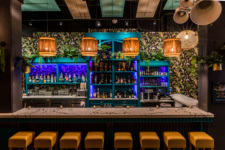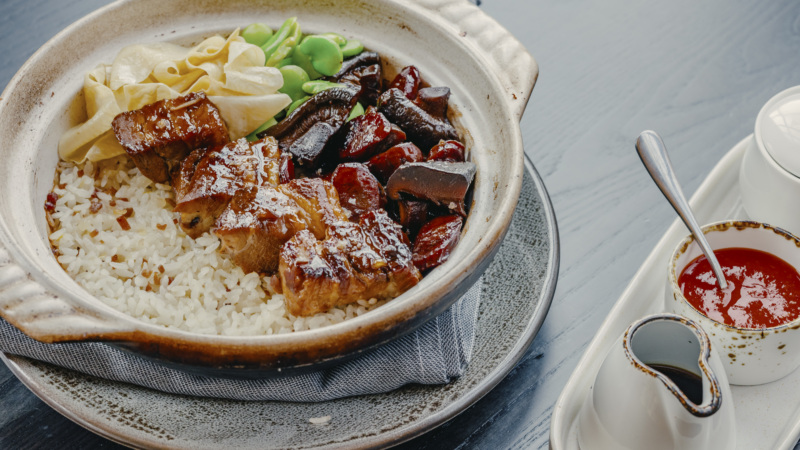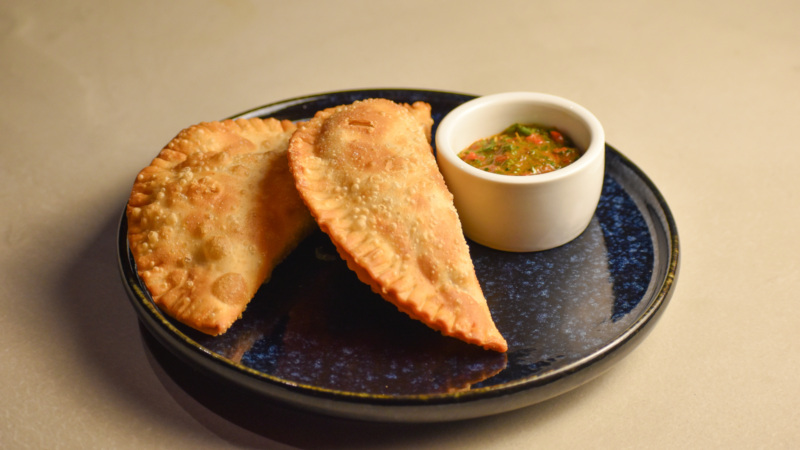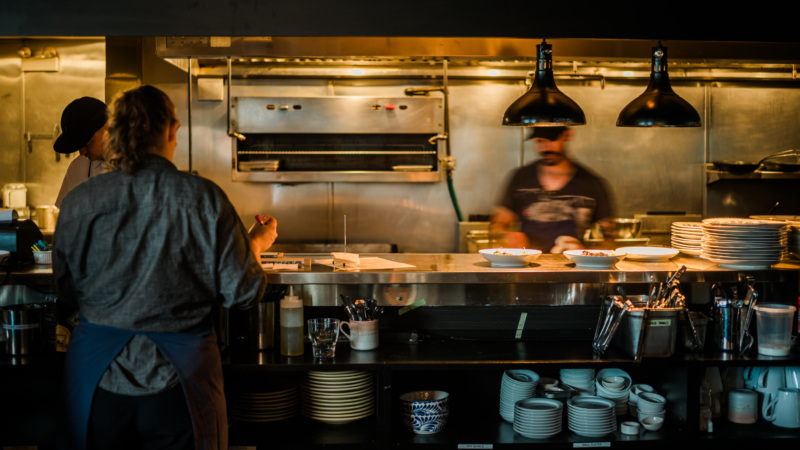
At Cebu in Chicago, It’s Always a Filipino Family Affair
When Cebu opened in Wicker Park in 2019, it promised a laid-back spot to celebrate the flavors of regional Filipino cuisine. It’s also very much a family affair, as siblings Malvin Tan (chef de cuisine), Cybill Tan (pastry chef), and Marlon Tan (business brains) each pursued their own paths in far-flung locales (England, China, Australia) before joining forces to open this restaurant in Chicago.
After the siblings found their space, naming the restaurant after their beloved island province was a natural choice. “We always want to have an inviting and family feel here — the goal is to make guests feel like they’re at someone’s home or backyard. Cebu’s vibe really stems from our Filipino culture, which brings people together through food,” Marlon says.
Marlon says that growing up around family-run businesses informed the Tan siblings’ entrepreneurial aspirations as adults. “Even though it has its challenges, working with family is really great,” he says. “Each of us compliments one another in terms of what we bring to the table.” Here, Marlon walks us through a few of his favorite dishes on the menu.


Lumpia
“Lumpia is probably the most famous Filipino dish. In ours, we incorporate Berkshire pork with diced carrots, mushrooms, garlic, and onion. Then we marinate it with oyster sauce, rice wine, sesame oil, and a dark mushroom soy sauce, which adds a little bit of umami flavor. Then we wrap all of that in a thin pastry skin and deep fry it for a few minutes until it’s perfectly golden brown. We serve it with a housemade pineapple sweet and sour sauce made with rice wine vinegar.
“Our lumpia is pretty traditional, but some of the sauces we use are not so traditional. Normally, lumpia doesn’t have oyster sauce or sesame oil, but my brother wanted the meat to be juicier. A lot of the techniques he uses come from his time in culinary school, which was French-focused. You’ll see that he adds some French influences and includes his personality in the dishes.”


Sizzling Gambas
“Originally, this is a Spanish dish, served tapas style. For ours, we first make a sauce with calamansi, oyster sauce, garlic, black pepper, soy, chili flakes, and banana ketchup, which is sweeter than your usual ketchup. [Historical side note: Banana ketchup was created by a Filipina woman named María Orosa when there was a shortage of tomatoes after WWII.]
“So we take a sizzling plate, add the prawns, and then add that sauce. It’s one of my favorite dishes because it’s very light, but super flavorful with those sweet and spicy notes. You can typically find this in the Philippines in restaurants, and even though ours is pretty traditional, I think that the oyster sauce is our personal touch.”
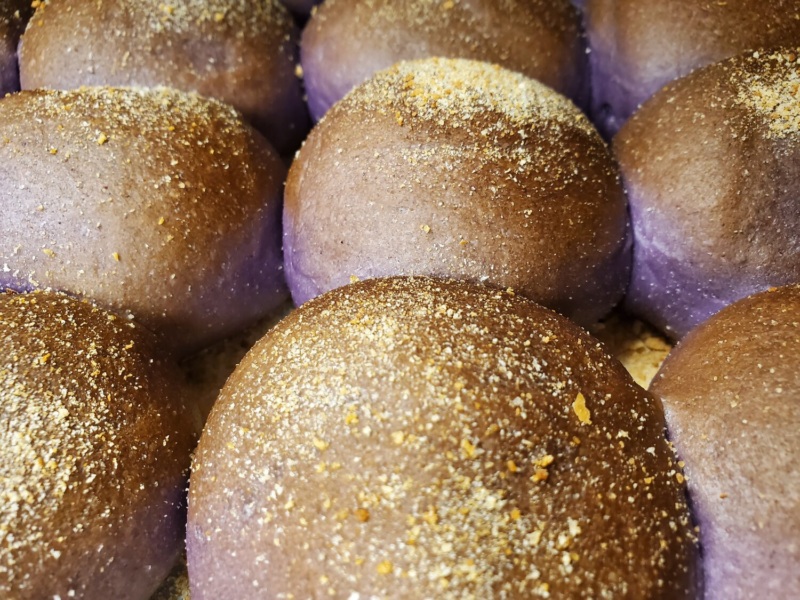

Ube Cheese Pan de Sal
“Pan de sal is very commonly eaten for breakfast in the Philippines, or as a snack with coffee. The name pan de sal dates back to Spanish colonization and just means ‘bread with salt.’ It’s interesting because a lot of our dishes have Spanish names, but they could mean something different in Spain or somewhere else.
“Pan de sal is similar to a dinner roll, but a bit softer. Typically, they’re not filled with anything, but ours are, which is our modern take. My sister, the pastry chef, incorporates ube, purple yam, into the dough so the bread comes out purple. Ube tends to be a little bit sweeter than your typical sweet potato, and they’re common in Southeast Asia and the Polynesian side, and starting to grow in popularity here in the US as well. Then she stuffs the bread with cream cheese and ube jam. The finished pan de sal are very soft and creamy, savory from the cream cheese, and sweet from the jam — they’ve been selling like crazy.”


Cebu Lechon
“We get our pork belly from Slagle Farm in central Illinois and season it with my brother’s secret rub, which is sweet and salty — almost like a barbecue dry rub. Then we layer lemongrass, green onions, red onions, and anise, and roll it up, similar to porchetta. Then we tie it and roast it in an oven for three to four hours, while basting the skin with soy sauce every half-hour so that it crisps up. Once it’s done, you have this incredible texture, where the skin is crispy and the meat itself is very moist, decadent, and full of that lemongrass and anise flavor.
“A whole roast pork is a classic Spanish dish and each Latin American country will have its own lechon. The Philippines also has lechon, but because there are over 7,000 islands in the Philippines, each region has a different way of making it. In Cebu, we’re pretty famous for this dish and a lot of people think our version is the best in the Philippines. We cook it a little differently. Other regions don’t stuff the pork and they use other sauces and flavors. Anthony Bourdain went to Cebu and said our lechon was one of the best he had ever tasted, so we’re proud of that.
“We serve ours with rice and an atchara salad, which is kind of like sauerkraut, but it’s sweeter. Think of sweet pickled vegetables. It’s traditionally made with papaya, but we use cucumber, red bell peppers, and carrots, and pickle them with sugar and rice vinegar. It’s our way of cleansing the palate.”


Halo-Halo
“Halo-Halo is a very famous dessert in the Philippines, especially when it’s hot in the summer. You can find it at restaurants, street stands, or small shops. The translation literally means ‘mix mix,’ so you eat it by mixing everything together.
“Traditionally, the base of the dessert is shaved ice, then you would pour milk over that and then add toppings. But I think ours is special because we make ube milk, freeze it, and then shave it for the base. Shaving the frozen ube milk gives our halo more of a milkshake consistency. From there, we add toppings like coconut, palm sugar jelly, red beans, and ice cream, and then to enhance the crunchy texture, we add granola.
“In the Philippines, the toppings will vary depending on what region you’re in. It’ll usually come with ube or mango ice cream but some regions add bananas or other fruits. We like to add jelly and red beans, and a piece of flan on top, which is our mom’s flan recipe. You could truly put whatever you want on halo-halo. Everyone has their own.”
Elanor Bock is a Chicago-born professional writer, dancer, and Renaissance woman. Follow her on Instagram. Follow Resy, too.



